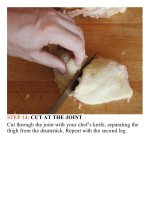The food lab better home cooking through science ( PDFDrive ) 772
Bạn đang xem bản rút gọn của tài liệu. Xem và tải ngay bản đầy đủ của tài liệu tại đây (133.79 KB, 2 trang )
tempestuousbrotherprefershiswell-done.What’san
understandingandgeneroushosttodo?
Firstoff,youshouldwonderhowyourbrotherwascreated
out of the same genetic material as you.After that, you’ve
got a couple options. Because most roast are not an even
shape, you’ll probably end up with a few pieces that are
more cooked than others, even when you cook with very
gentleheat.Theseslicesgenerallycomefromneartheends
of the roast, where energy is penetrating the meat through
more surfaces. If those pieces are still not cooked enough
foryourbro,thebestthingtodoistakehisslices,stick’em
on a rimmed baking sheet, and throw them back into the
ovenuntiltheyarethedesiredshadeofdry.
LEFTOVERS
Q:Grampsdecidednottoshowupfordinner—what’sthe
bestwaytostorehisleftovers?
An all-too-common dilemma. For short-term storage, your
bestbetistojusttightlywrapthemeatinplasticandkeepit
in the fridge. It’ll last for around three days. Bear in mind
that rare or medium-rare meat may turn brownish
(remember myoglobin?) in the fridge but this isn’t
necessarily a sign of spoilage. For that, just follow your
nose!
For longer-term storage of larger pieces of either cooked
oruncookedmeat,you’llwanttofreezethem.Ifyou’vegot
a vacuum-sealer, use it. Air is the enemy of frozen food,
causing it to dry out in an irrevocable process known as
freezer burn. If you don’t have a vacuum-sealer, wrap the
meat tightly, first in foil (plastic wrap is not airtight) and
thenafewlayersofplasticwrap,andplaceitinthefreezer.
The plastic wrap helps keep the foil tightly against the
surfaceofthemeat,whilethefoilpreventsairfromcoming
incontactwithit.
Letyourmeatdefrostintherefrigerator.Thiscantakeas
longasacoupledaysforlargercutsofmeat.
Q:DidIhearthatright?Plasticwrapisnotairproof?
That’s correct. Air can still travel through plastic wrap,
thoughquiteslowly.
Q:Whataboutreheating?
Ifyouarewise,youwillhavebeenslicingthemeattoorder,
leavingyouwithalargechunkofleftoverroastratherthan
many thin slices.The best way to reheat a large chunk of
meat(thickerthan1½inches)istotreatitlikeyouwoulda
steak, which after all, it is: warm it in a low oven until it is
about10degreesbelowthedesiredservingtemperature(see
thecharthere),thensearitinahotskillettocrispandbrown
theexterior.Forthinnercuts,youcansimplysearthemina
skillet straight from the fridge, just like a steak.
Alternatively, the microwave is surprisingly effective. Just
rememberthiscardinalrule:nomatterhowyoureheatit,do
notletitriseabovetheinitialtemperatureyoucookeditto,
oritwillbeovercooked.
If you’ve already sliced the whole roast extremely thin,
yourbestoptionissandwichesandsalads.Stilldelicious!
Q:Whataboutthosechefswhocooktheirprimeribs









